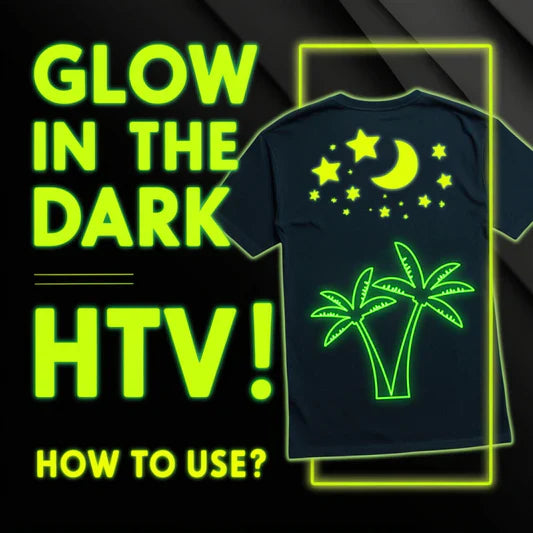
Are you planning to start a heat transfer vinyl business, or are you just a home crafter who would love to design with HTV? You should not only know how to apply this amazing crafting material, but also where to apply it, so that it gives excellent performance for a long time. The best material for HTV printing projects is cotton. In this blog, we will discuss in detail the different types of materials you can use for successful HTV designing. This is to give you a clear understanding of what works and how to make your projects last beautifully for many years.
What Is Heat Transfer Vinyl Printing?
Heat transfer vinyl is an amazing material for designing shirts, t-shirts, hoodies, and other apparel made of compatible fabrics. It is available in many different colors and finishes, giving you ample room to be creative when designing. A premium-grade heat transfer vinyl has a strong adhesive that requires heat and pressure for activation. It forms a robust bond with the fabric, giving excellent performance for up to 50 wash cycles. You would need a heat press and an automated cutting machine, such as Cricut or Silhouette, to professionally design with HTV. Presented below are the best fabric materials for HTV designing:

Cotton
Pure cotton fabrics are great for heat transfer vinyl printing. This is a breathable fabric known for its durability. It has high endurance for heat, and your design will adhere well to it. It is used to make t-shirts, hoodies, tote bags, home textiles, and baby garments due to its skin-friendly nature. Wash it before designing and iron it thoroughly to remove the risk of shrinkage, wick away moisture, and get rid of wrinkles completely.

Cotton Blends
Cotton blends are fabrics made by combining cotton with synthetic or natural fibers such as polyester, spandex, or rayon. These are also excellent for designing with heat transfer vinyl, especially if the cotton content is high in them. Wash them as well to avoid shrinkage and remove wrinkles.

Polyester
Polyester is a synthetic fabric made from petroleum-based fibers. It is known for its strength, wrinkle resistance, and ability to retain shape over time. Unlike natural fabrics, polyester is less absorbent, making it quick-drying. You can design it with HTV, but pure polyester is a heat-sensitive material, so you must keep the temperature low to avoid scorching it. You can customize activewear, sports uniforms, and outdoor gear made with polyester.

Burlap
Burlap is also a fabric made from natural materials like cotton, but it has a slightly rough texture and can have an open weave, which might distort your design or affect adhesion. Heat transfer vinyl can be applied easily on burlap, and it looks good, but you will have to tweak the process a bit by applying more heat and pressure to make the vinyl stick properly. Use burlap with a tighter weave for best results. You can make HTV-designed banners, table runners, gift bags, pillowcases, and other home décor items.

Canvas
This is another great fabric for heat transfer vinyl designing. It is plain, woven material typically made from cotton or a cotton-poly blend. You can creatively customize tote bags, aprons, and shoes made with canvas. You can also make wall hangings with it using stretched canvas. For this material as well, you will have to increase the heat and pressure settings to allow HTV to stick properly.

Denim
Apply HTV on denim, and you get the liberty to personalize so many things that you wear every day, making them truly your own creations. This thick, durable cotton fabric is woven in a twill pattern, giving it a distinctive diagonal ribbing. You can design jeans, jackets, bags, and accessories made with denim. Use high temperature and strong pressure, and HTV will adhere strongly to it for a long-lasting finish.

Leather
Heat transfer vinyl also looks good on leather, allowing you to design your wallets, handbags, jackets, coats, belts, shoes, gloves, and more. It will not only customize the item but will also make it look stylish and one-of-a-kind. This is also a heat-sensitive material, so care must be taken when applying vinyl to it. You can lower the temperature, use firm pressure, and increase the application time slightly. Do not forget to put parchment paper or a Teflon sheet on top when designing leather goods with HTV.

Wood
Yes. You can apply HTV on wood provided it is treated and completely smooth. Heat transfer vinyl gives a painted feel to your design with a rustic look. You can work on wooden signs, ornaments, wall hangings, keychains, and more. Temperature and time must be adjusted accordingly for wood. It is best to use a sealant over your design for the longevity of your craft.

Heat Transfer Vinyl Printing Project Ideas
There is no dearth of ideas when it comes to heat transfer vinyl printing on the right kind of material. From designing apparel to making home decor items, you can experiment with different colors, textures, and finishes. You can personalize shirts, T-shirts, jackets, hoodies, onesies, pants, jeans, and other such items. In accessories, you can design any that are made with fabrics, such as pouches, belts, tote bags, shoes, headbands, and the like. If you want to upgrade home decor, apply HTV to pillowcases, wall hangings, curtains, table mats, covers, and more.
Best Heat Transfer Vinyl
You can buy the best heat transfer vinyl from TeckWrap Craft. We offer an extensive variety of colors and finishes. All our HTV products are crafted with the finest polyurethane, which is durable and gives excellent performance over time. Our films are easy to cut, weed, and apply, and can easily be used by both professional crafters and hobbyists. Here’s what we offer:
-
PU Heat Transfer Vinyl: This is a flexible and lightweight HTV with a glossy finish. You can get basic, neutral, pastel, and neon shades in this.
-
Glitter HTV: This is a shimmery heat transfer vinyl film with minute flecks of glitter all over it. It transforms your garment from plain to glamorous in an instant. You can get Puff, Glow-in-the-Dark, UV Color-Changing, and Ombré Glitter HTV.
-
Holographic HTV: This fabulous film has an excellent shimmer with a psychedelic play of colors when light falls on it from different angles. We also offer Holographic Shimmer HTV with an extra dose of shine.
-
Metallic HTV: This is also a high-shine heat transfer vinyl film with a metal-like finish. There are different types available in this, such as Holographic, Pearlescent, and Metallic Chrome.
-
Glow in the Dark HTV: This is a magical film that absorbs ambient light during the day and gives off a soft glow when exposed to darkness all around. You can design apparel with this for themed parties. It is also available in Puff and Glitter variants.
-
Puff Heat Transfer Vinyl: The puff heat transfer vinyl rises upon application of heat, giving your designs a remarkable 3D effect, as if it is protruding out of the fabric. This is the favorite HTV for children’s garments.
-
Reflective HTV: This heat transfer vinyl has a shimmery surface that reflects light when it falls directly on your design, enhancing its visibility. It is best for safety gear or outfits worn by cyclists at night, so they can be seen in the dark.
-
Color-Changing HTV: This is another magical film that changes shades when exposed to UV light. Your designs will be of a different color when you are indoors. When you go out, the shade will change in sunlight, mesmerizing all.
-
Pattern HTV: If you love a display of vibrant colors, you should certainly get our Pattern Heat Transfer Vinyl. It looks fantastic against a monochrome background. You can get Colorful Splash and PU Rainbow Stripes HTV in this.
Tips For HTV Projects
- Always take care of the temperature, pressure, and time settings when using HTV with different fabrics and adjust accordingly depending on their heat-resistance.
- Do not forget to place parchment paper or a Teflon sheet on top of your design when applying heat. It should be big enough to cover the part of the fabric that will be exposed to heat.
- If applying HTV on wood, make sure that it is properly sanded and treated. It should be completely smooth. Use a sealant afterwards for the longevity of your project.
- Use the right cut setting for different types of HTV films, and do not forget to mirror your design.
Frequently Asked Questions
Q. What material is best for heat transfer?
Cotton and cotton blends are the best for designing with heat transfer vinyl. They endure heat well and give long-lasting results. Pre-press the fabric to remove moisture and creases, and eliminate the risk of shrinkage for better adhesion.
Q. What is the best vinyl for leather?
Heat transfer vinyl is the best for leather apparel and accessories. Leather can get scorched easily, so use a lower temperature and firm pressure for best results.
Q. What is the best HTV finish when decorating fabrics?
This depends on your preference. Those who don’t like high shimmer can use PU HTV for their projects. If you want a glamorous look, Glitter HTV is the best, and if you like flashy designs, go for Metallic or Holographic Heat Transfer Vinyl.
Achieve HTV Crafting Success Across Different Materials
It's time to gather your supplies, get the right material, and start designing with heat transfer vinyl. The secret lies in using the right temperature, pressure, and time settings. For premium-quality, durable heat transfer vinyl, browse through the collection at TeckWrap Craft and get the rolls delivered to your door in no time.


















